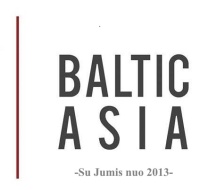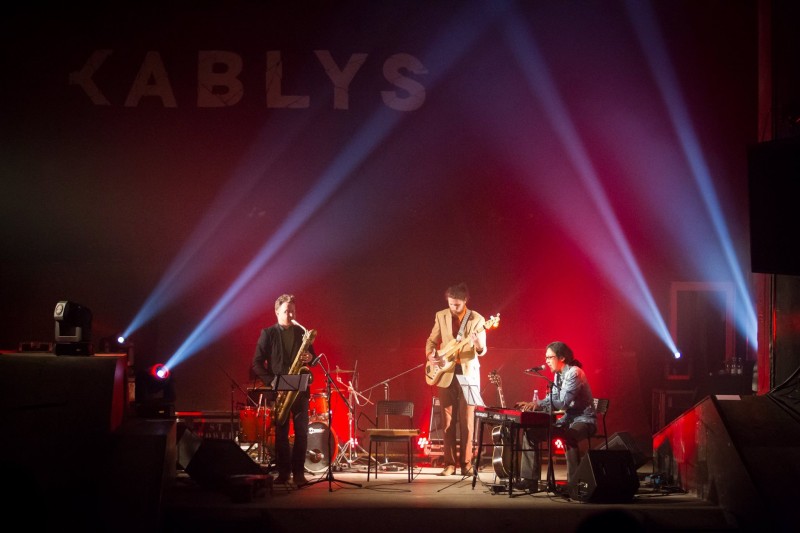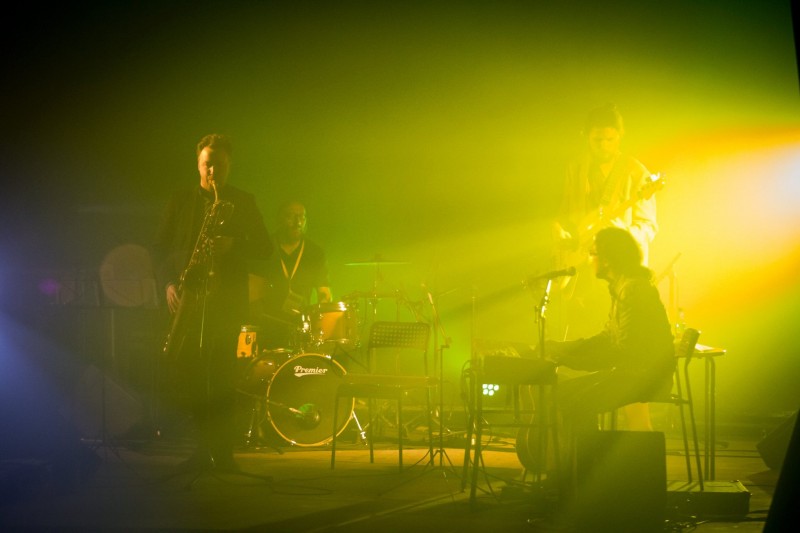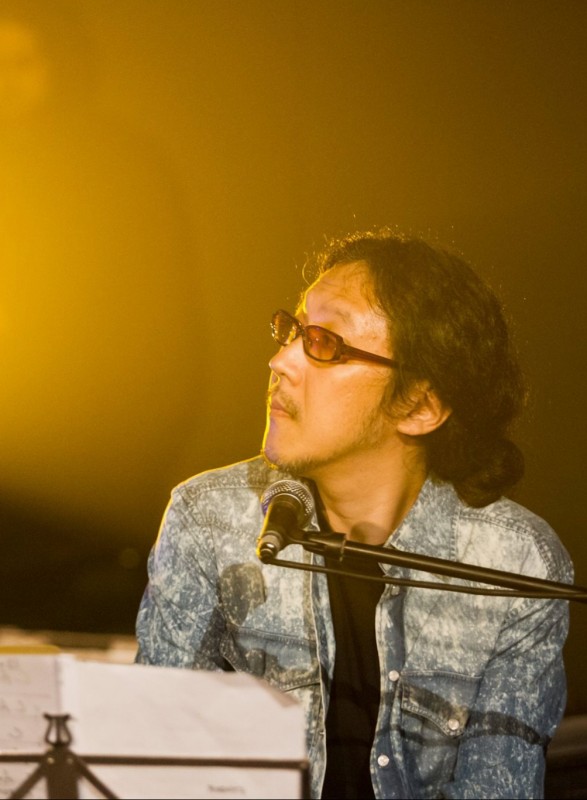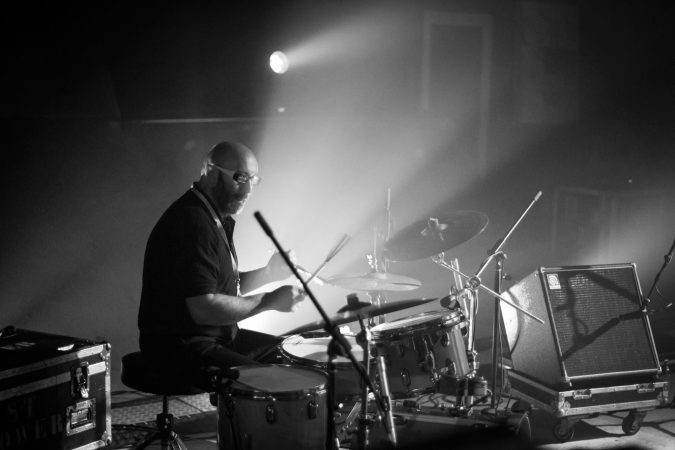On the evening of the 23rd of October, one of the most enthusiastic and energetic Lithuanian jazz virtuosos Remigijus Rančys (sax), Arkadijus Gotesmas (drums), Mykolas Bazaras (bass) and the author of famous Japanese anime “Hellsing” soundtrack, Yasushi Ishii (vocal, keyboard) gathered together to create a unique sound that would surpass any language and cultural barriers in Vilnius jazz bar “Kablys.” The group collaborated by being invited by „Made in Japan“ festival team. Without allowing the evening’s steamy jazz vibes and emotions to cool off, “Baltic Asia” member interviewed the musicians Remigijus Rančys and Yasushi Ishii about their performance, involvement in the project, and the process of making music.
About the festival
Japan-Baltic Design Week is organised by the people of another long-running cosplay festival “nowJapan,” that is being organised for more than eight years. No longer fitting into the format of pop-culture that is mainly oriented at cosplay and anime obsessed youth, the organisers set new goals to attract a more diverse audience. One that is interested in the tendencies of traditional and contemporary Japanese art and music and is eager to get to know professional Japanese designers and musicians. Simona Širvydaitė-Šliupienė, the Project Executive, told us how the “Made in Japan” idea was born: “Sergej Grigorjev is the author of the project’s idea. While visiting Japanese designers at their home in Japan, Sergej noticed some weaved Baltic-styled baskets displayed on the cupboard. After having expressed his surprise, the Japanese showered with praise the hand-made baskets. Unfortunately, the only place that such baskets find here are in the country’s villages storing potatoes. We do not put any value on them. And that’s how the research begun, during which we raised the important question ‘What are the values of design?’”
Seven concerts were organised during the Japan-Baltic Design Week: four of them in Vilnius, the rest – in Šiauliai, Palanga, and Taujėnai. In addition, there were organised a two-day conference, a design fair, and a note-worthy networking evening, during which many high-profile people were invited, such as Japanese and Lithuanian designers, musicians, the Lithuanian Minister of Culture, Japanese Ambassador to Lithuania, conference key-note speakers, and members from city municipality. “It’s a unique happening. We have Japanese invited from all over Japan, also designers from Lithuania, Latvia, Estonia, and even Finland.” marked Simona.
Did you know anything about each other before agreeing on doing the performance? What was the deciding factor that led you to participating in “Made in Japan” project?
Rančys: I didn’t know anything about Yasushi before the project. Only upon starting the communication with him did I find out that he has created music soundtrack for some famous Japanese animation. I tried to look him up on the Internet, but since every search would come up in Japanese, I felt like a white sheet of paper: I didn’t know who, or what, or what this is all going to be about. But once we met, I immediately felt connected with that musician. He was a rather reserved person (but maybe that’s the trait of many Japanese people); however, I really liked his music. His voice is so “pure”: slightly husky, yet far-reaching.
The offer itself was to simply play together and get involved in the festival. I am always interested in such collaborations as in the past I have as well participated in similar projects with Africans and Brazilians. It is always an exciting experience as you get immersed in new ideas that come with different cultures. I think it was a great opportunity to get a feel for Japanese culture. Together we created music, performed, traveled, talked, rehearsed, and ate.
Ishii: Even though we didn’t know each other, I felt a huge sympathy for the idea of “Now Japan” and “Made in Japan”, since I also enjoy Japanese-related stuff. That was my deciding factor to participate in the project.
How did your music come together? Could you feel the influence of a different culture in your own playing or was it more of a universal feeling of music (what jazz is usually known for)?
Rančys: It does not matter of what country or cultural background musician you are – each person brings something new and unknown with their playing. In the programme, we offered all sorts of genres, varying from world music, to pop music, to jazz elements. To me, Yasushi‘s songs are the prime example of what Japanese music sounds like. Although his music has some similarities with the sounds of pop/rock music, when listening to the singer‘s vocal timbre, the whole experience of it immediately takes you away to Japan. Something similar to when you start singing Lithuanian sutartinė on top of any sort of musical texture – we will immediately feel and recognise that this is something Lithuanian. Thus, I believe that at least all the vocal pieces sounded truly Japanese.
When we were playing my pieces, Yasushi quickly and with flexibility adapted to our music. Hence I think that instrumental pieces had more of jazz and improvisational feel to them.
Ishii: [Universal feeling]. It wasn’t until today that I received new chords. I had to improvise and then it made me realize that this is what Jazz looks like.
How did it feel playing on the stage for you tonight? Were there any surprises or unexpected moments of improvisation?
Rančys: We felt very good. Although we did run into a few problems during our first performance, today we already knew what we should expect. I wish there were five more concerts. But unfortunately, there were only two and we already need to say goodbye. But oh well, it was a great experience.
Ishii: At my opening performance, I experienced one trouble. While I was playing “Gion-shoja no kane no koe” (“The sound of the bell of Gion-shoja“), piano pedal had something wrong with it and I had to extend my one leg to reach the pedal… I think I ended up playing the piano in weird position that turned into an unexpected improvisation. (Ishii laughs while recreating the situation on the chair he’s sitting on)
In all the advertisements of the concert, it wasn’t you or Mr. Ishii being advertised, but the protagonist of “Hellsing,” Alucard. What do you think of it? Do you know anything about anime and maybe watch it as well?
Rančys: I know very little about anime. I am only familiar with Hayao Miyazaki and Osamu Tezuka, whom both I really love. I even have created one piece dedicated to Hayao Miyazaki, called “Hayo,” that I have performed together with Africans. However, due to time restraints, we couldn’t play it during the concert. And regarding “Hellsing,” I didn’t know anything about it, but now I will give it a shot.
Then, after enjoying Miyazaki’s works, this is going to come as a big contrast…
Rančys: Well, I can already deduce from the suggestive symbols that this is about slightly different things… (smiles)
How would you evaluate “Made in Japan” project?
Rančys: I didn’t have any preconceptions about it nor did I hear much about the festival beforehand, thus my opinion of it is very good. I received a handful of good experience and impressions, starting from team organization and finishing with the experience of the concert itself and the opportunity of getting to know the Japanese artists. I liked the whole organisational team: could really feel the good atmosphere among the organisers. I appreciate the opportunity given to me to participate in the project.
You were getting ready for the concert rather unusually. Due to the distance between your countries, you had to rehearse remotely. Did such practice work in the end? Or did you run into some challenges and misunderstandings?
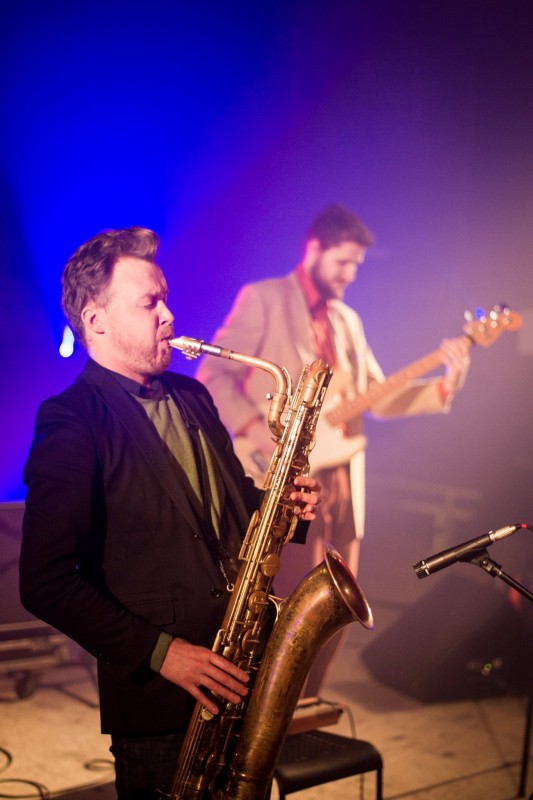
“I felt like a white sheet of paper: I didn’t know who, or what, or what this is all going to be about”. Photo Artūras Samalius
Rančys: Music is truly universal language: once you start playing with a person, you immediately feel how everything works. Since Ishii is professional, he “caught up on us” pretty fast. For example, we ran through my pieces a few times and everything went smoothly during the concert. During the remote rehearsals we would discuss the strategy, what and how we would do things, record the sound, then Ishii would listen to it and approve it. Once we met in person, the music immediately came together.
Ishii: I made the arranged versions of my songs for different instruments: the piano, the drums, the bass, the sax and the vocal. We were sharing demo tapes or chords via the Internet. I felt anxious at first, since I had to explain complex musical notations in English and I am used to communicating with others only in Japanese.
One of the pieces performed during the concert, described as evening’s one of the most atmospheric and sensual pieces, was dedicated to Dostoevsky. Remigijus, what importance does the piece hold to you?
Račys: Just like all the musicians, you are always in the process of playing and creating. That is our everyday reality and every melody that I create, requires a title. You cannot just write “3,” “8,” “12”… That is why I use a simple method: I try to remember what was going on in my life around the time I created the melody.
There is a short story behind it. At the time, I lived and studied in Denmark. I fell ill and had to stay in bed on my own for a few weeks. I was really bored, but next to me there was laying Fyodor Dostoevsky’s “Idiot.” I had plenty of time to take in the story and the “Dostoevsky-esque” outlook on life really left a big impression on me. Once I got well again, I sat down at the piano and started playing while thinking of Dostoevsky. And that’s how the piece was born. I still perform it from time to time with different people.
What are your near future plans? Do you plan on continuing such fruitful collaboration with each other?
Rančys: Yes, I would really like to continue such collaboration with Yasushi Ishii. The time now was too short: we barely got play together and already have to separate our ways.
I also really liked the other pair of festival’s musicians Aco & Taca. I talked with the organisers if they plan on continuing the festival next year, I would like to make the arranged music for strings and to invited the musicians to play together. I was impressed by the female musician’s “untamed” voice.
Ishii: I haven’t performed in a lot of concerts during my life. I would like to do more live performances more actively. If I would get invited to Lithuania next year, I’m sure I would come back again.
To many anime fans, Yasushi Ishii and his works are associated nearly exclusively with the world of “Hellsing.” However, apart his famous works, there is little information available about the musician, and his works are shrouded in mystery. “Baltic Asia” took the opportunity to interview the Japanese artist about his works and share his thoughts on what inspires him to createhis music.
Is it your first time visiting and playing in Europe?
Yes. I was offered many new things on this occasion. Not only it was my first time performing in Europe, but it was also my first time holding my own concert.
What do you think about Lithuania so far?
My first impression was that Lithuanian ladies are cheerful. However, on the contrary to this bright side, on my way to the concert venue, I saw some junkie people. Thus, it seems that the country faces some social problems as well.
You present yourself in different music genres, varying from acid jazz to hard rock, and your songs often offer a lot of contrasts and variety, sometimes embracing strong dramatism and lyricism at once. How did you come to embrace such different music? What fosters your creativity and influences your music the most?
Now I have mastered many different music instruments. That is result of my job, during which I was required to make different types of music, varying from anything from jazz to rock music. Though personally, I like to listen to acid jazz the most, however, as a job I had to listen and master all sorts of music styles.
I get hooked on Buddhism and “Zen” highly affects me. Zen is a way of being. The essential idea of Zen is to abandon the desire and not to stick to anything. Thanks to it, I do not get too attached to anything in my own music, thus gradually letting a lot of variety into my own playing.
So religion opens a way for your creativity?
That is one of its roles. Furthermore, what is necessary for my life is Buddhism. It attracts me without any specific reasons. Religion is kind of spice, which flourishes my life.
You have created music soundtracks for such anime as “Hellsing” and “Darker than Black.” Do you have some personal sympathy for anime? Do you have any favourites?
During my childhood, I would watch anime daily, such as “Kyojin no Hoshi” (famous 60s-70s anime about baseball) and “Doraemon.” Anime is part of my daily life rather than my interest.
My current favourites are “Hellsing” and “Darker Than Black.” (smiles) Kouta Hirano’s style of drawing really attracts me. [“Darker Thank Black” was created by Tensai Okamura, ed. note]
In your song “Darker than Black” from the anime of the same title you reference Ziggy Star. Did David Bowie play an influential role in your life?
It’s true that I like David Bowie. However, after I wrote the melody, the lyrics didn’t come to my mind easily. Ziggy Star appeared just by chance, as a reference to Bowie’s character living in space.
Could you tell us more about the process of creating music soundtracks for anime? Does the visual aspect of anime help or restrain you from releasing your fantasy and creativity?
When it comes to the production of music soundtracks, the director gives me his requests and orders, something that goes like, “This kind of music is needed in this particular scene.” However, it’s not interesting for me to obey the orders and to create what I was asked the way it was asked. I always try to put my essence and philosophy into my products as much as I can.
You have created music soundtrack for Kouta Hirano’s “Hellsing” and now we can hear your song in another soon-to-be-released anime “Drifters” by the same author. Is there some special relation you feel to Hirano’s work? What can we expect from the new soundtrack?
I feel a strong connection with Mr. Hirano, as if we’re drawed to each other by some sort of attractive force. “Hellsing” is based on Christian and European world of view, while “Drifters” shows the story of Japan. Hence I would like to bring something Japanese or something related to Buddhism into this music.
Thank you for your time and interview and I wish you all the best in continuing this collaboration in the future.
English translation by Sida Nakrošytė.
Japanese translation by Yasufumi Nakashima.
Photography by Artūras Samalius.
